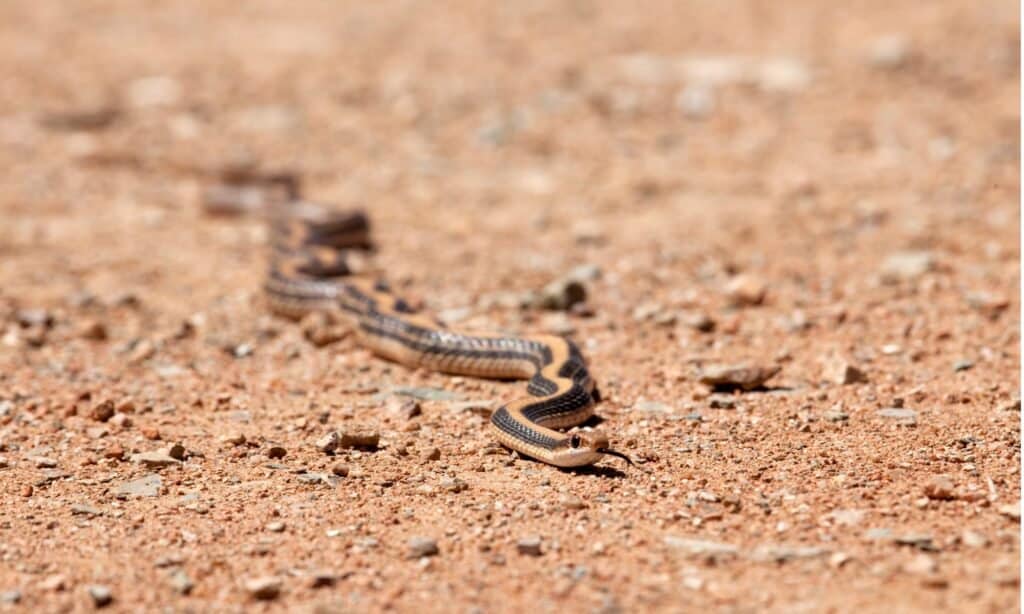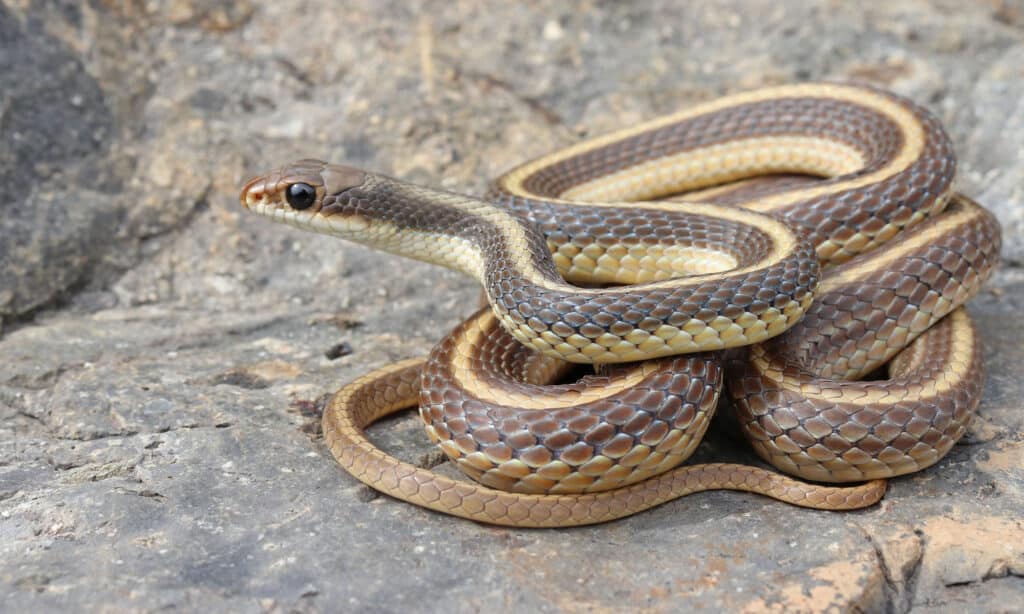Continue reading for our analysis...

Living rooms are chill zones. You have comfy couches, your favorite TV shows, and snacks (not snakes!) at hand. But for this Arizona man, a chill zone quickly turned into a hell-no zone.
Watch Rattlesnake Solutions experts in action in this video as they move in as heroes of the hour.
Are Western Patch-nosed Snakes Venomous?

Western patch-nosed snakes can grow up to 46 inches long.
©iStock.com/milehightraveler
Western patch-nosed snakes (scientific name: Salvadora hexalepis) are non-venomous. These snakes may grow between 20 and 46 inches in length (with a record length of 58 inches) and have distinctive features that allow you to easily tell them apart from other types of snakes. There are a variety of subspecies, and they are all a bit yellow and black with lateral stripes in different displays.
The recognized subspecies include:
- Salvadora hexalepis hexalepis
- Salvadora hexalepis klauberi
- Salvadora hexalepis mojavensis
- Salvadora hexalepis virgultea
They have smooth dorsal scales and a divided anal plate. They have a characteristic, thick scale that is free at the borders and curves back above the peak of their snouts. These snakes feed on small mammals like mice, reptiles like lizards (along with reptile eggs), and birds. Whereas other snakes constrict their prey with their bodies, western patch-nosed snakes take a different approach. They loop their bodies on top of their prey to restrict their movement and overcome them.
Where Do Patch-nosed Snakes Live?

Patch-nosed snake with distinctive features, including yellowish and blackish colorations.
©Creeping Things/Shutterstock.com
That depends on the type of patch-nosed snake! The western patch-nosed snake resides in desert environments with arid conditions like those in California, Nevada, Arizona, West Texas, and New Mexico. Desert patch-nosed snakes don’t just dwell in deserts. They also thrive in grasslands, brushlands, rocky hillsides, and sandy plains. They can be found in California, Mexico, and southeastern Arizona.
Arizona Man vs. Western Patch-nosed Snake

The western patch-nosed snake resides in desert environments with arid conditions.
©
In this video, Rattlesnake Solutions comes in to save the day. Marissa from the Snake Relocation Team is off on a call to help a man who fears snakes. He saw one slip into his living room and head underneath his couch — he was very clear he wouldn’t be able to sleep that night if Marissa didn’t come by to find it and get it the heck out of there!
As if hopping into her Batmobile, she heads out with purpose. She arrives at the man’s home, and he welcomes her in, describing the features of the snake as “long and skinny, not round.” He walks her into the living room and starts explaining where it may have gone. Marissa, with her trained eye, spots it right away and asks, “Is that him up there?” The man looks over and exclaims, “Yeah! That’s him!”
He is surprised he didn’t notice it and Marissa giggles. Immediately, she knows it’s a patch-nosed snake. She approaches it with her bucket and tongs as it slithers behind the man’s collection of trophies. As she works, she explains they’re harmless as she moves the trophies to get to them.
She foregoes her tongs as the snake slithers into a narrow space just behind some curtains and expertly grabs it with her bare hand! Although a scary situation for the man, Marissa knew exactly what to do.
Discover the "Monster" Snake 5X Bigger than an Anaconda
Every day A-Z Animals sends out some of the most incredible facts in the world from our free newsletter. Want to discover the 10 most beautiful snakes in the world, a "snake island" where you're never more than 3 feet from danger, or a "monster" snake 5X larger than an anaconda? Then sign up right now and you'll start receiving our daily newsletter absolutely free.
Thank you for reading! Have some feedback for us? Contact the AZ Animals editorial team.






